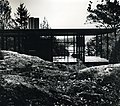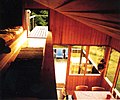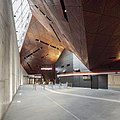Private House, Söörmarkku, 1966
Private Swimming Hall, Turku 1967 demolished
Private Swimming Hall, Turku, 1967, demolished
Villa Suojaranta, Merimasku, 1968
Villa Vainiola, Aura, 1970
Helsinki Metro sign system 1970-82
Finnish State Railways sign system, G4 1976 - 82
Finnish State Railways sign system, G4 1976 - 82
Villa Björköholmen, Pargas, annex, 1974
Villa Björköholmen, Pargas, annex, 1974
Kumpula, University Area competition entry A+P, 1978
Pori Music- and congres Hall, competition entry A+P, 1981
Pori Music- and congres Hall, competition entry A+P, 1981
Rautavaara Church A+P, 1982
Rautavaara Church A+P, 1982
The Official Residence of the President of Finland, competition entry A+P, 1983
The Official Residence of the President of Finland, competition entry A+P, 1983
Hansasilta Shopping Mall and pedestrian bridge, Itäkeskus, Helsinki, A+P 1984
Hansasilta, Helsinki A+P, 1984
Laajasalo Church, Helsinki, competition entry A+P, 1984
Botanical Garden and Glass House, Joensuu University, A+P 1985
Forest Research Center, Kannus, A+P 1985
Private House Koivikko, Helsinki, 1985
Private House Koivikko, Helsinki, 1985
Kurkimäki Multipurpose House, Helsinki, A+P1989
Kurkimäki Multipurpose House, Helsinki, A+P1989
Tampere Hall, A+P 1990
Tampere Hall A+P
Office building Rautio, Espoo, A+P 1990
Office building Rautio, Espoo, A+P 1990
Viikki Triangle Cemetery, Helsinki, together with Leena Lisakkila, A+P 1990
Bus Shelter, Public Design '92, Espoo, 1992
Kauhajoki School of Domestic Economics, renovation and annex 1992
Kauhajoki School of Domestic Economics, renovation and annex 1992
Seinäjoki railway station, pedestrian tunnel and platform shelters 1993
Seinäjoki railway station, pedestrian tunnel and platform shelters 1993
Luuniemi Housing Area, Iisalmi competition entry 1993
Hietaniemi cemetery, Helsinki, Lighting fixtures 1993
Hietaniemi cemetery, Helsinki, Lighting fixtures 1993
University of Helsinki metro station, platform hall, Helsinki 1995
University of Helsinki metro station, platform hall, Helsinki 1995
Pikku-Huopalahti Multipurpose House, Helsinki 1997
Pikku-Huopalahti Multipurpose House, Helsinki 1997
Vuosaari metro station, Helsinki 1998
Vuosaari metro station, Helsinki 1998
Helsinki 2nd Training School renovation and annex 1999
Pormestari Pedestrian bridge, Pori 2001
Helsinki Railway Station, Platform Roofing 2001
Helsingin Railway Station Platform Roofing 2001
Kehä 1 traffic noise barries, Kannelmäki-Lassila, Helsinki 2002
Kehä 1 traffic noise barries, Kannelmäki-Lassila, Helsinki 2002
Leppävaara Exchange Terminal, Espoo 2002
Rataruukki Polska, Technology Center, Zyrardow 2002
Bus-Joker, Oulunkylä-Viikki, Helsinki 2003
Bus-Joker, Oulunkylä-Viikki, Helsinki 2003
Mikael Agricola Church, renovation, Helsinki 2004
Mikael Agricola Church, renovation, Helsinki 2004
Koivukylä railway station, Vantaa 2004
Koivukylä railway station, Vantaa 2004
Kallio Municipal Offices renovation, Helsinki 2004
Mikkola School, Vantaa 2005
Mikkola School, Vantaa 2005
Mäntsälä railway station 2006
Mäntsälä railway station 2006
Ruukki Factory, Bolintin Deal, Romania 2008
Keilaniemi metro station, Espoo (ALA+ESA) 2009-2017
Keilaniemi metro station, Espoo (ALA+ESA) 2009-2017
Aalto University (Otaniemi) metro station, Espoo (ALA+ESA) 2009-2017
Aalto University (Otaniemi) metro station, Espoo (ALA+ESA) 2009-2017
Aalto University (Otaniemi) metro station, Espoo (ALA+ESA) 2009-2017
Tampere Hall, renovation and annex 2015-2017
Tampere Hall, renovation and annex 2015-2017
Tampere Hall, renovation and annex 2015-2017
Tampere Hall, renovation and annex 2015-2017
Tampere Hall, renovation and annex 2015-2017
Tree House, Björköholmen, Pargas 2011-














































































